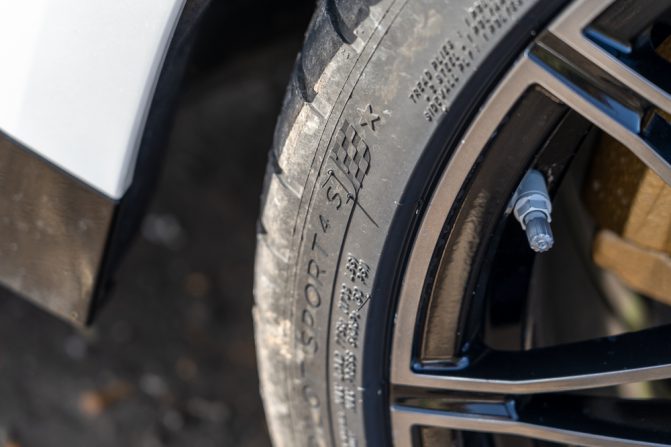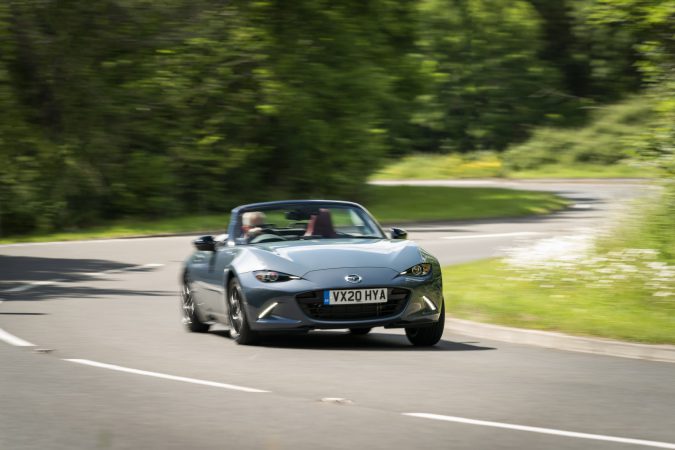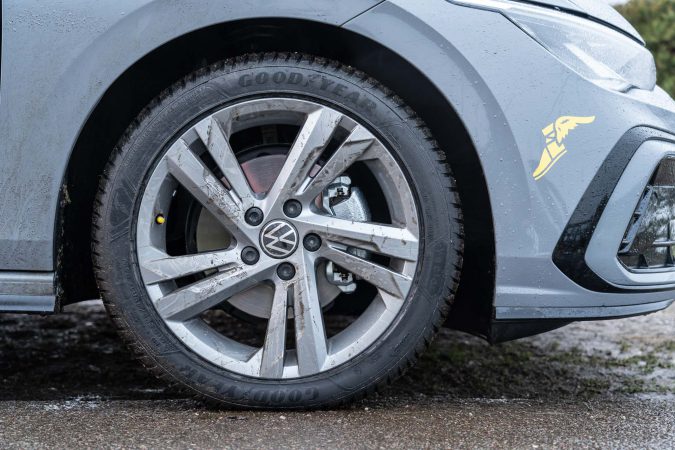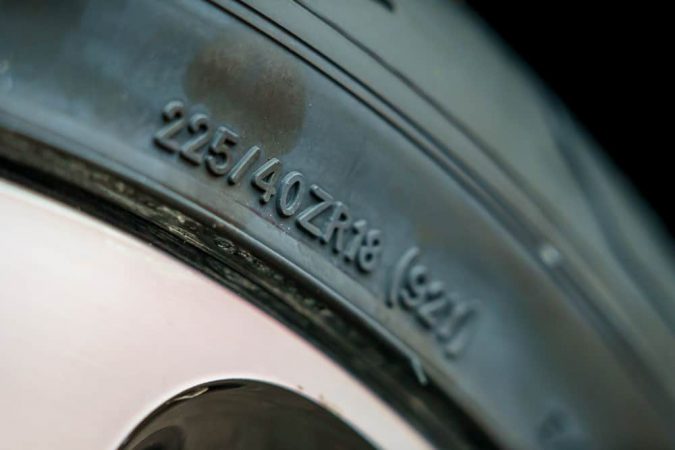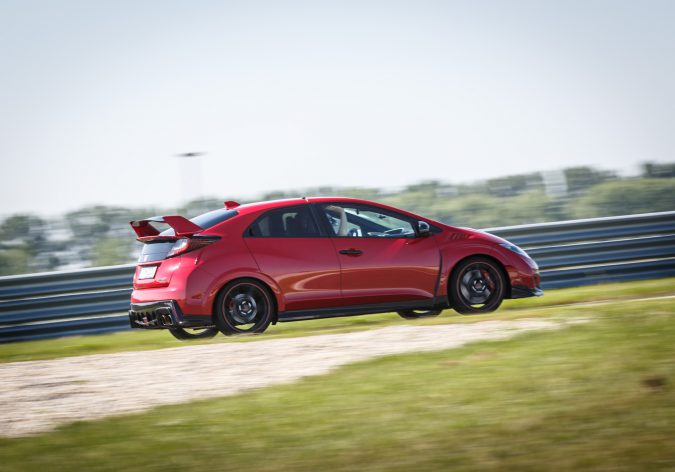The V and H speed ratings on tires are quite common, but which one is right for you? We’ll take a look at tire speed rating V vs H, and everything else you need to know about tire speed ratings.
Tire Speed Rating: What Are They?
As it implies, the tire speed rating is the maximum speed your tires can safely go while carrying their maximum load. The rating starts from as low as A1 which is 3mph, to as high as (Y) which is above 186mph.
Speed ratings were first used in Germany in the 1980s. As cars got faster, a speed rating became necessary so drivers know how fast their tires can go.
The unrestricted Autobahn also plays a part, since they didn’t have speed limits, drivers can go as fast as their heart fancy since they won’t get into legal trouble. Tire speed rating became necessary so drivers know their limits, and they’ll have to fit tires with a higher speed rating if they want to go faster safely.
It’s important for you to know your tires’ speed ratings so that you know your car’s limits. If for example, you have a tire rating of H, then you can safely go as fast as 130mph with those tires. That’s not to say they can’t go more than their rating, but it will be unsafe to do so.
Speed Rating V VS H And Other Common Tire Speed Rating
There are a total of 30 speed ratings for tires. But in tires for modern cars, there are 10 speed ratings you’re likely to encounter. For passenger cars such as sedans and minivans, you’re most likely to encounter these:
- S Speed Rating, up to 112mph.
- T Speed Rating, up to 118mph.
Since most passenger cars have a top speed of under 120mph, you’re most likely to encounter those. Meanwhile, trucks and offroad SUVs will often have these speed ratings:
- N Speed Rating, up to 87mph.
- P Speed Rating, up to 93mph.
- Q Speed Rating, up to 99mph.
- R Speed Rating, up to 106mph.
Trucks typically have a lower top speed. And the tires focus more on load strength and offroad capability since that’s what often matters for trucks and offroad SUVs.
Then you get to the H-rated tires, which, as mentioned, can safely travel up to 130mph. This is often used in passenger cars with slightly higher performance or small sports coupes like the Mazda MX-5.
After that, you get to performance tires that you’ll find in sports cars such as the BMW M4 and even supercars:
- V Speed Rating, up to 149mph.
- W Speed Rating, up to 168mph.
- Y Speed Rating, up to 186mph.
You’ll typically find the V speed rating in semi-performance-focused cars, such as the Audi S4 and other high-end spec sedans and coupes. Meanwhile, W and Y ratings are often used by performance-focused cars such as the BMW M4 and its rivals which usually have an electronically-limited top speed of 155mph.
As for the (Y) rating, as mentioned it can safely travel above 186mph and you’ll find this in performance cars and supercars. Additionally, you’ll also find a ‘ZR’ in the size designation, this indicates the tires are safe to use at speeds above 149mph.
Tire Speed Rating V VS H: Which One’s Better?
As mentioned, the H speed rating means the tires can travel up to 130mph. Meanwhile, the V speed rating can travel up to 149mph. So, the V speed rating is better right? But the battle of speed rating V vs H is not quite that simple, there’s a bit more to it.
Tires achieve a higher speed rating by using a softer rubber compound, optimized tread patterns, and stiffer construction. The soft rubber compound and tread patterns mean they’re able to find more traction and hence making them safer at higher speeds. While the stiffer construction makes them more stable during cornering as there’s less flex.
All this means they have better high speed and cornering performance, ideal for sports cars and eager drivers. However, it often means less ride comfort. While not always the case, the stiffer construction can make the ride feel stiffer, not ideal for comfort.
Additionally, the softer rubber compound can also affect tire life. Softer compounds will stick to the road better, but this does mean they leave more rubber on the road, leading to faster degradation. So, expect tires with higher speed ratings to have a shorter tread life.
Does this mean the H rating is better then? It all depends on your needs. If you have a performance car, it’ll be safer to have tires with a higher speed rating such as the V speed rating, even if that means a shorter tire life.
Meanwhile, if you don’t drive a performance car, you probably won’t benefit from using tires with a higher speed rating. To help you decide on your tires, here’s our buying guide:
Speed Rating V VS H: Understanding Tire Ratings And Indicators
Those writings on the tire’s sidewall can be confusing. While there is plenty of useful information, there are four things you must pay attention to when buying tires. These are the tire size, the load rating or range, the load index, and of course, the speed rating.
These ratings and indicators will help you decide on which tire you should buy. It may all seem like gibberish, but let’s decipher them. We’ll be using 225/40ZR18 92Y as our example:
Tire Size
The first three digits (in this case 225) are the measure of the tire’s width in millimeters. So, in this case, the tires are 225mm wide, as simple as that. The next number is the sidewall’s size or height measured in percentage of the tire width. Don’t ask us why they use that measurement, the tire industry seems to just love to confuse us.
Anyway, 40 means that it’s 40% of the tire’s width. The higher the number, the taller (or thicker) the tire sidewalls are. Thicker sidewalls mean the tires will be more comfortable, as they have more rubber to absorb bumps and jolts. But it flexes more, making it less stable during cornering.
Finally, the R stands for Radial construction as opposed to diagonal bias-ply construction which we don’t use anymore in modern cars. And the final number (in this case 18) is the wheel size that the tires will fit in inches, meaning this tire will fit 18-inch wheels. Also, our example has a ‘ZR’ rather than just ‘R’, this means the tires can go over 149mph.
If you’re not changing to aftermarket wheels, stick with the tire size you currently have. You may pick tires with taller sidewalls for better comfort, provided it’s no more than 10% thicker as you risk hitting the tires to the wheel.
Load Rating And Index
This is often overlooked while buying tires, but you also need to understand the maximum load your tires can carry, especially if you often carry a lot of things such as for work or family trips.
Tires have a load rating (or sometimes referred to as load range) and load index. The load rating is the maximum amount of tire pressure the tires can handle while carrying their maximum load. For ‘Passenger’-type tires it’s quite simple, they’re either Standard Load (SL) or Extra Load (XL).
Tires with an SL rating have a maximum inflation pressure of 35psi, while XL-rated tires can handle up to 41psi. You can inflate the tires to higher than that, but it won’t be safe for a prolonged period. If the tires don’t say SL or XL, then it means it’s an SL-rated tire.
However, LT or Light Truck tires have a slightly wider rating range. This is because LT tires are stronger and are made out of 6 plies/layers or more. While Passenger tires have an industry standard of 4-ply. To learn more about Light Truck tires and load rating, read here.
Meanwhile, the load index is a numeric code that indicates the maximum amount of load (weight) the tire can carry. It ranges from 0 to 150, the higher the number the more weight it can carry. In our case, it’s 99 which means it can carry 1,389lbs. Multiply that by four (since your car has four tires), the tires on your car can handle up to 5,556lbs.
Your owner’s manual should tell you the recommended tire load index and we recommend sticking to that recommendation. So, if the manufacturer recommends a 92 load tire, stick with that or higher if you know you’re going to be carrying heavy loads.
Speed Rating
In our example, the Y speed rating means the tires can travel up to 186mph. The 92Y rating means the tires can travel up to 186mph while carrying a maximum load of 5,556lbs.
Much like the load index, we recommend sticking to the tire speed rating that your manufacturer recommends or higher. Tires with a lower speed rating may be cheaper, but this means you won’t be able to drive as fast, and it’s possibly unsafe to do so.
So, when do you need to purchase a higher tire rating? There are two instances that we can think of: when you feel like you need better handling, and when you’ve modified your car, increasing its power output.
As mentioned, a higher speed rating means the tires have a stiffer construction, making it flex less when cornering and likely resulting in better handling. However, keep in mind that the tire sidewall size, tread pattern, and overall construction also play a big role in handling. After all, not all tires are built equal even if they have the same specs.
However, if you’ve modified your car and now you have more power output, you’ll want to consider a higher speed rating. Especially if you want to take your car to a race track where you can exploit its full potential.
It may not matter on public roads since we’re all bound by the same speed limit. But if you’re going to take your car to a track, you’ll benefit from using higher-performance tires.
The bottom line, stick to the manufacturer’s recommendations. But if you’ve made significant performance upgrades, you’ll want high-performance tires, preferably V-rated or higher with a ‘ZR’ designation.
Speed Rating V VS H: Recommendations
Now, even after understanding all of that, buying tires can be confusing. The tire industry just loves to confuse customers. There are many manufacturers and models to choose from. Not to mention, there are summer, all-season, and all-weather tires.
Don’t worry, we did your homework for you. Keep in mind that tires can come with either a V or an H speed rating even when they have the same size. So, our recommendations are not based on the speed rating but will be based on what your need may be:
1. Best In The Dry: Michelin Primacy 3
First, let’s take a look at summer tires. As the name implies, this type of tire is ideal for dry conditions only and you should use them if you live somewhere that’s sunny all year round, such as the sunshine state of Florida.
Our top pick goes to the Michelin Primacy 3. It provides excellent traction in the dry, decent wet braking performance, it’s quiet and comfortable, and comes with a 40,000-mile warranty which is quite rare for summer tires.
It’s available in many different sizes and will fit wheels ranging from 16-inch to 19-inch. As for the speed rating, it’s available with an H, V, W, and Y speed rating, although this varies depending on the tire size. While the load index ranges from 87 to 104 depending on the size as well.
Price starts at around $197 per tire for smaller ones, while larger diameter ones will easily cost over $300 per tire. This makes them quite expensive, but it’s the best summer tires you can find out there. Oh, one more thing to note, this being a summer tire don’t expect wet handling to be stellar. For that, best take a look at our next option:
2. Best All-Weather Tires: Firestone WeatherGrip
Let us clear something first: all-weather tires are geared towards winter driving. So, they’re ideal for heavy rain and light snow, without compromising dry performance too much. Meanwhile, despite its name, all-season tires are more than capable of handling summer driving, with decent performance in mild winter conditions.
The key difference between tire types is the tread patterns and rubber compound. Winter, all-season, and all-weather tires have deeper patterns. Additionally, their rubber compound stays soft in lower temperatures, with winter tires having the lowest freezing point. But we digress.
Anyway, consider all-weather tires if you live somewhere that occasionally experiences winter conditions. You’ll have decent performance in wet and snow, without losing too much in the dry. Ideal if you don’t want to change your tires depending on the season. Our pick goes to the Firestone WeatherGrip tires.
This tire is available for 16-inch wheels to as large as 19-inch wheels. It’s available with either an H or V speed rating (depending on the size), and some are also available with an XL load rating. Additionally, it has a Three Peaks Mountain Snowflake (TPMS) rating which means it’s rated to deal with deep snow conditions.
It’s overall a very good tire, but it may feel a bit unresponsive in the dry and can be a bit loud on the highway. It’s really geared more towards winter conditions. The price starts at around $126 per tire for the smaller sizes, while the larger ones will cost up to $206 each.
3. Best All-Season Tires: Michelin CrossClimate
If you live somewhere that’s mostly dry but still get mild winter conditions, we picked the Michelin CrossClimate Plus as the best performing all-season tire. It’s a good all-rounder in the dry, wet, and even snow.
However, it does have a couple of caveats, namely poorer wet braking performance than its competitors, and loud tire noise at high speeds in the dry. Aside from that, it’s probably the best all-season tire you can buy out there.
Price starts at around $120 to as high as around $260 each. It comes with Michelin’s 40,000-mile tread life warranty. There are plenty of sizes available, going as high as 20-inches and with either an H or V speed rating. If you drive a crossover or an SUV, there’s also the Michelin CrossClimate SUV, but expect them to be pricier.
For more on all-season tires, you can visit our guide to all-season tires.
4. Best Winter Tires: Bridgestone Blizzak WS90
How about winter tires then? For those of you who live in regions with extreme weather, the Bridgestone Blizzak WS90 is a good all-rounder. It has best-in-class braking on dry surfaces, excellent traction on snow and ice, and as Tire Deets puts it, “outstanding handling and traction in rainy conditions.
Come sun, rain, or snow, the Blizzak WS90 seems to be able to take almost anything the weather throws at it. Of course, it’s not without downsides. Some customers note that it can feel a little firm over bumps. And while it has a long tread life, Bridgestone doesn’t provide a treadwear warranty.
Prices start at around $119 to as high as around $229 each, and they will fit anywhere between 14 to 20-inch rims. This being a winter tire meant for snow, you probably won’t be going fast. So it mostly comes with a T speed rating and tops out with an H tire rating.
5. Best For Trucks And SUVs: Continental TerrainContact
If you drive a truck or an SUV, consider the Continental TerrainContact. It’s available as either a Highway-Terrain (H/T) or All-Terrain (A/T) tire. Keep in mind that this will be best for on-road and light offroad use. For offroad tires, you’ll need to consider other options.
Apart from a subpar performance in mud and rocky surfaces, it’s an excellent all-around tire for your truck and SUVs. It’s available in many sizes and will fit as large as 22-inch wheels.
Meanwhile, the speed rating varies depending on the size. R, S, T, and H speed ratings are available, but no V speed rating. Understandable since trucks and off-road-oriented SUVs typically have a lower top speed anyway.
Prices start from around $178 and go as high as $268 each for the larger sizes. It comes with a 60,000-mile treadwear warranty, and it’s one of the best tires out there for your truck.
6. Best For Performance: Michelin Pilot Sport
Pirelli may be synonymous with motor racing, but when it comes to on-road performance, the Michelin Pilot Sport 4S is king. Multiple media outlets regard it as the best performance tires you can buy, period.
If you have a sports car, made significant modifications to your car, or any sort of performance-focused car, consider this Michelin. It will fit wheels as small as 17 inches, to as large as 23 inches. All of them come with a Y speed rating, meaning it’s safe for you to go up to 186mph.
Downsides? Well, they’re not ideal in winter conditions, and they can be prone to hydroplaning in heavy rain. If you want better all-season performance, the Michelin Pilot Sport All-Season 4 is probably for you.
Of course, a max-performance tire like this isn’t cheap. The smaller ones start at a somewhat reasonable $209 each. However, larger ones will easily cost somewhere between $300 – $400, with some costing as high as $568.
One more thing to note, if you want the best, no-compromise performance tire for track use, you have to consider the Pilot Sport Cup 2. These have even poorer performance in the wet, but they will provide ultimate grip and performance in the dry. Definitely necessary if you’re driving a supercar of sorts.
Tire Speed Rating Facts:
- Tire speed rating is a measure of a tire’s optimal safe speed.
- The higher the tire’s speed rating, the better its control and handling at high speeds.
- A tire’s speed rating is indicated by a letter from A to Z, with A being the lowest and Z being the highest.
- The speed rating system was developed in Europe to regulate tire performance at standardized speeds.
- The “Unlimited V” category of over 210 km/h (130 mph) was the top speed rating possible when the system was developed.
- The “Limited V” category of 250 km/h (149 mph) and eventually the “Z” speed rating were added to regulate tire performance as manufacturers developed bigger and better tires.
- The speed rating system does not indicate the total performance capability of a tire.
- The tire speed rating can typically be found in the owner’s manual, driver’s side doorjamb, glove box door, and gas tank hatch.
- Recent standardization has changed so all ratings except “Unlimited ZR” incorporate the speed symbol and load index as part of every tire’s service description on the tire’s sidewall.
- Tires with a maximum speed capability over 300 km/h (186 mph) require a “ZR” in the size designation.
Speed Rating V VS H: In Conclusion
So, what’s the conclusion to this speed rating V vs H battle? The key takeaway here is that V is a higher speed rating than H. The former can safely travel up to 149mph, while the latter tops out at 130mph. Any more than that, then it will be unsafe to do so.
When buying tires, pay attention to the speed rating, as that’s going to be the safe top speed you can reach with your car. We recommend sticking to the speed rating that your car’s manufacturer recommends or higher. It’s generally not a safe practice to go lower.

